Abstract
Porphyromonas gingivalis W50, W83, A7A1-28, and ATCC 33277 were investigated for their abilities to lyse sheep, human, and rabbit erythrocytes. All of the P. gingivalis strains studied produced an active hemolytic activity during growth, with maximum activity occurring in late-exponential-early-stationary growth phase. The enzyme was cell bound and associated with the outer membrane. Fractionation of P. gingivalis W50 localized the putative hemolysin almost exclusively in the outer membrane fraction, with significant hemolytic activity concentrated in the outer membrane vesicles. Ca2+ and Mg2+ ions significantly increased the expression of hemolytic activity. Hemolytic activity was inhibited by proteinase K, trypsin, the proteinase inhibitors Na-P-tosyl-L-lysine chloromethyl ketone and benzamidine, the metabolic inhibitor M-chlorophenyl-hydrazone, and iodoacetate. KCN and sodium azide (NaN3) only partially inhibited P. gingivalis hemolytic activity, while antiserum to whole cells of each of the P. gingivalis strains had a significant inhibitory effect on hemolytic activity. The P. gingivalis W50 hemolysin was inhibited by cysteine, dithiothreitol, and glutathione at concentrations of at least 10 mM; at low concentrations (i.e., 2 mM), dithiothreitol did not completely inhibit hemolytic activity. Heating to temperatures above 55 degrees C resulted in an almost complete inhibition of hemolytic activity. The effect of heme limitation (i.e., iron) on hemolysin production indicated that either limitation or starvation for heme resulted in significantly increased hemolysin production compared with that of P. gingivalis grown in the presence of excess heme.
Full text
PDF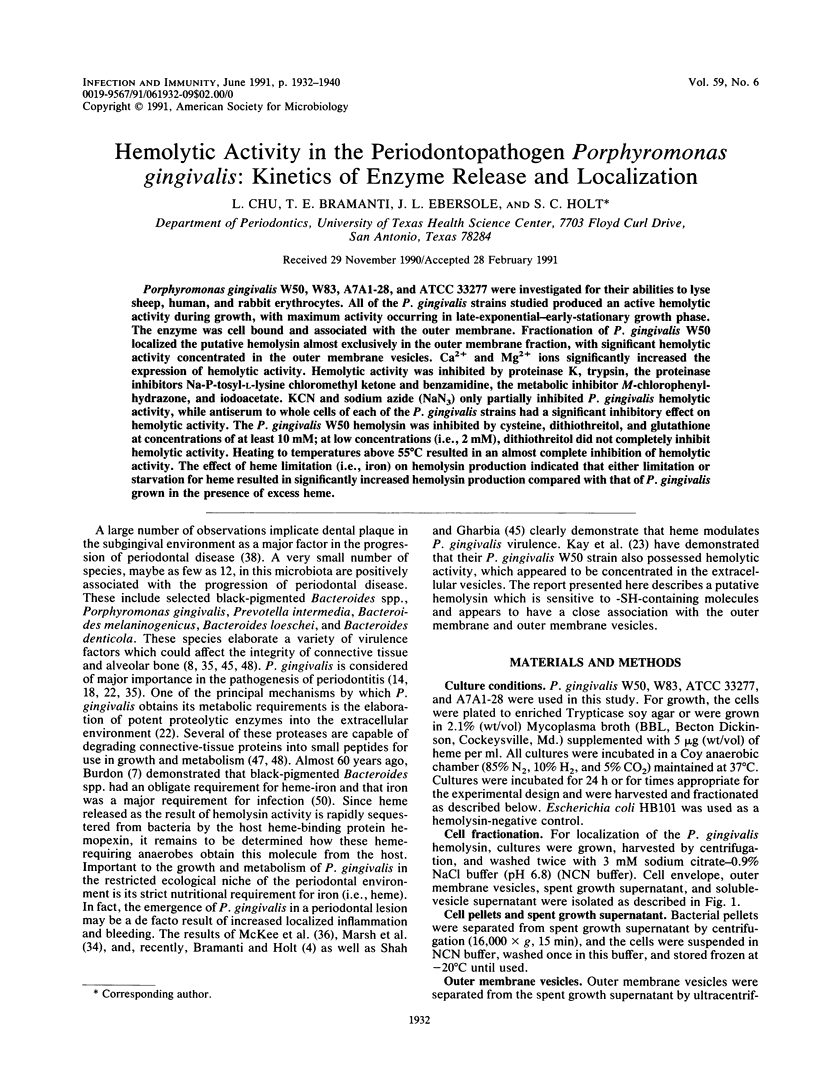
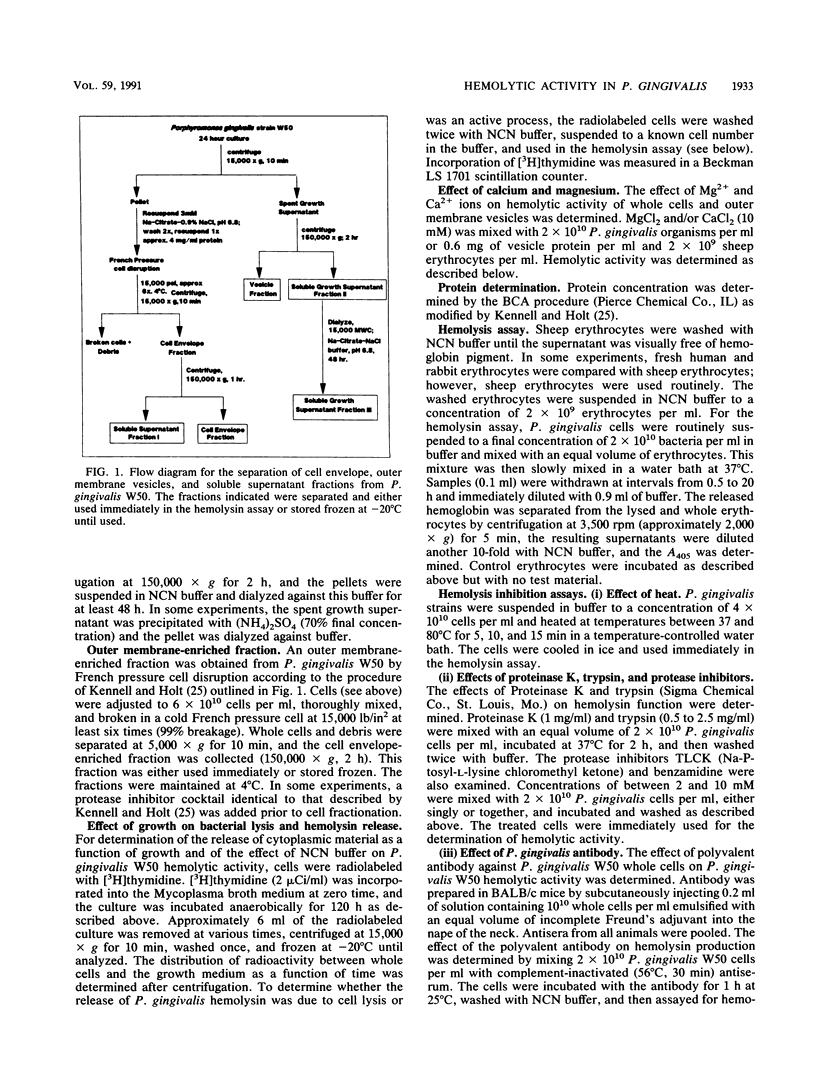
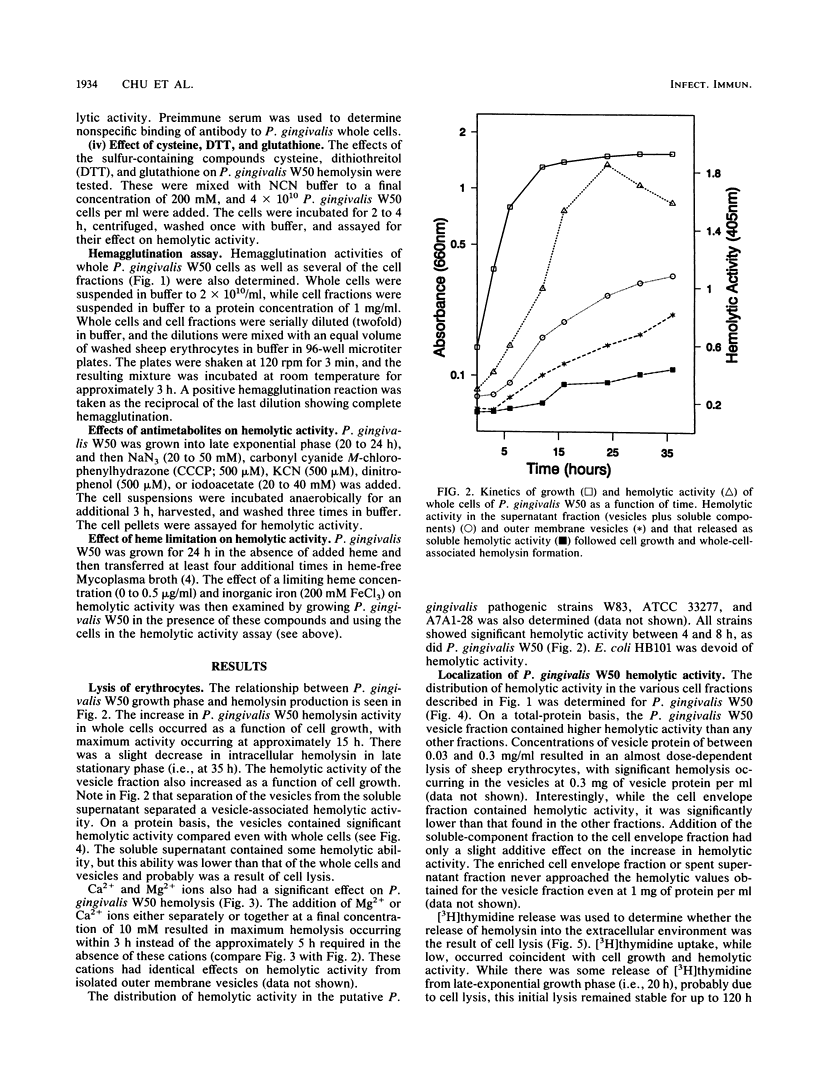
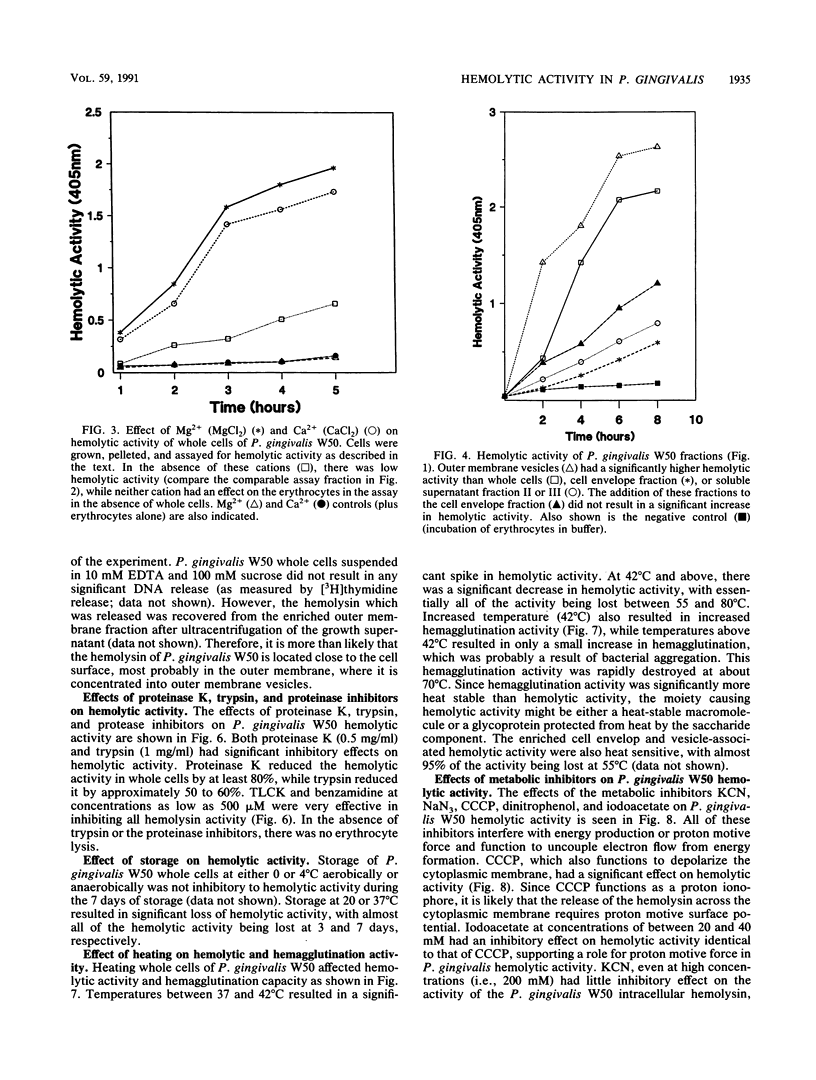
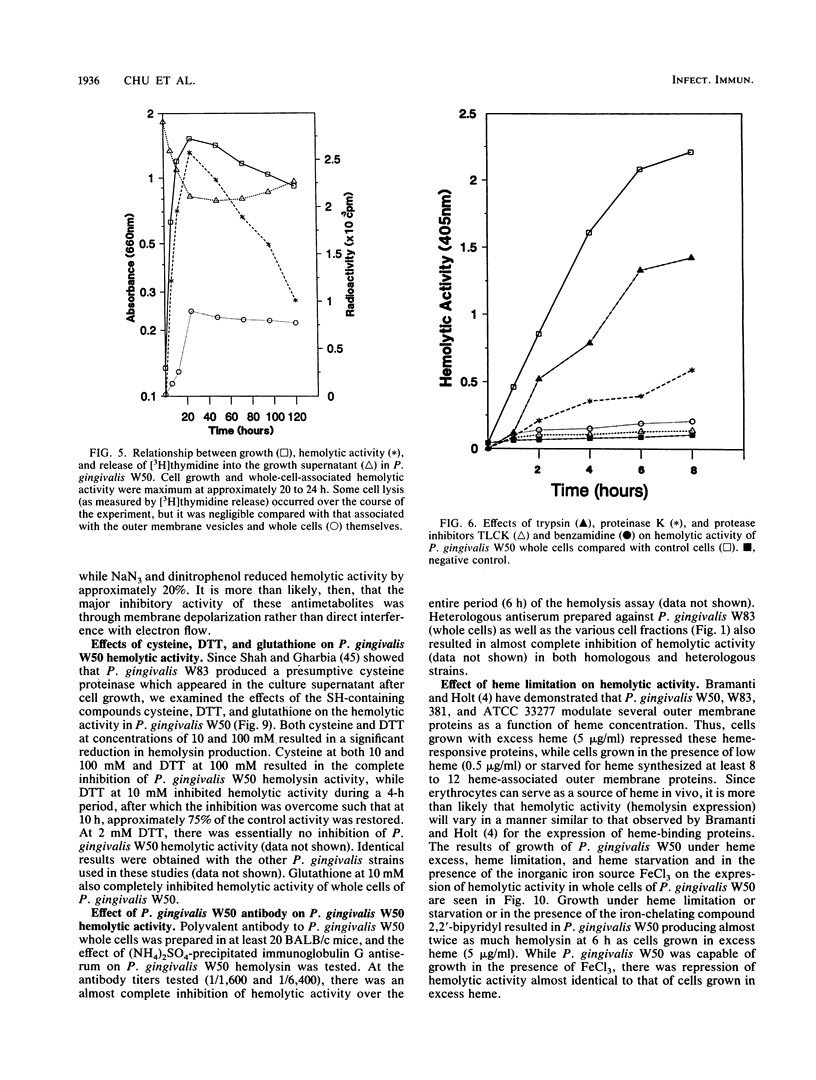
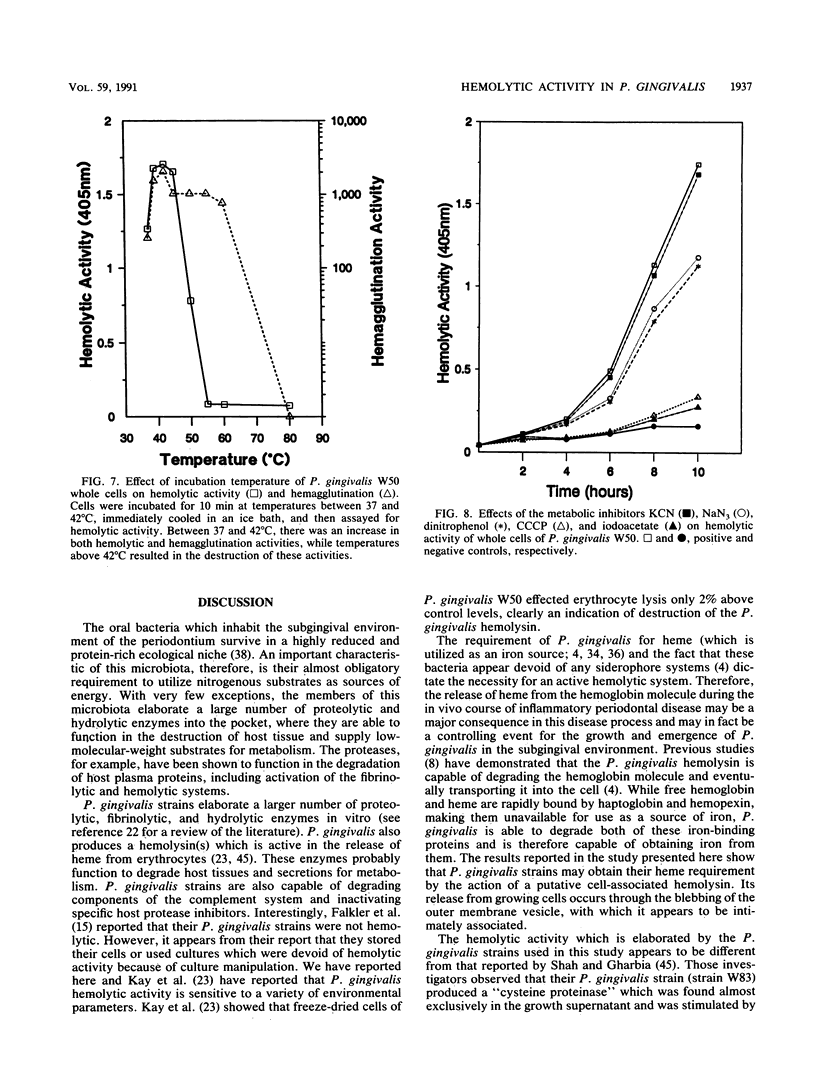
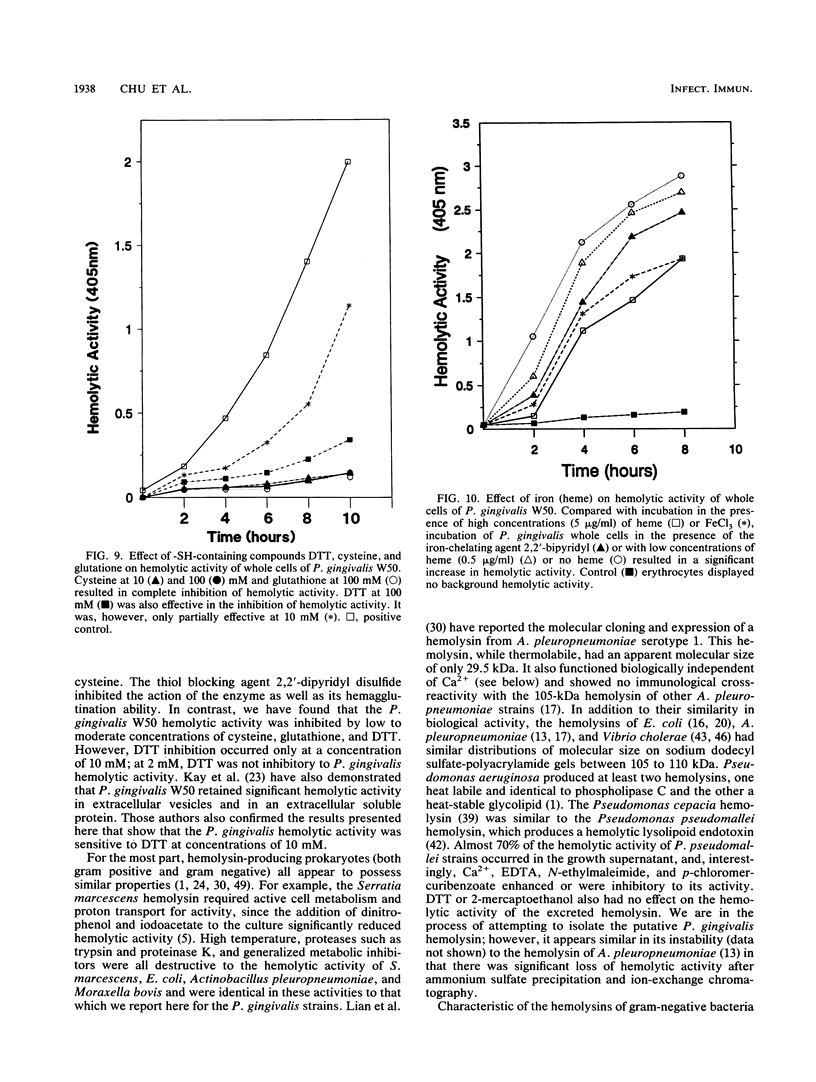
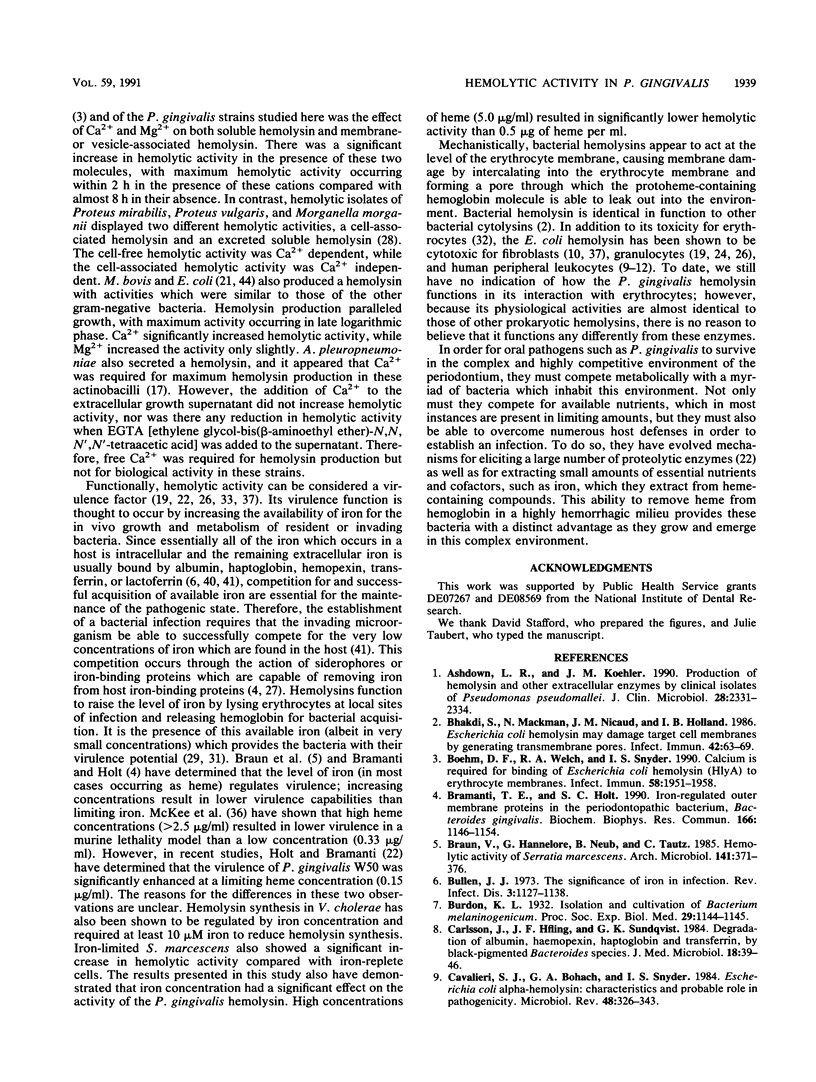
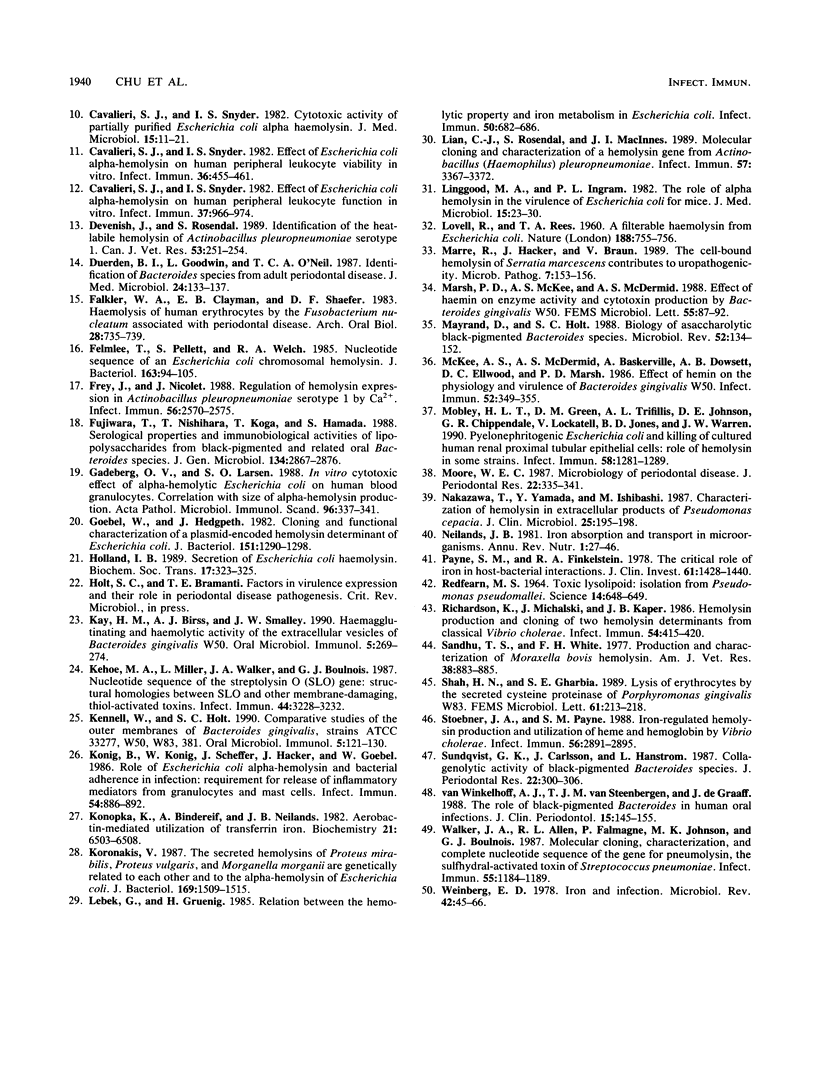
Selected References
These references are in PubMed. This may not be the complete list of references from this article.
- Ashdown L. R., Koehler J. M. Production of hemolysin and other extracellular enzymes by clinical isolates of Pseudomonas pseudomallei. J Clin Microbiol. 1990 Oct;28(10):2331–2334. doi: 10.1128/jcm.28.10.2331-2334.1990. [DOI] [PMC free article] [PubMed] [Google Scholar]
- Bhakdi S., Mackman N., Nicaud J. M., Holland I. B. Escherichia coli hemolysin may damage target cell membranes by generating transmembrane pores. Infect Immun. 1986 Apr;52(1):63–69. doi: 10.1128/iai.52.1.63-69.1986. [DOI] [PMC free article] [PubMed] [Google Scholar]
- Boehm D. F., Welch R. A., Snyder I. S. Calcium is required for binding of Escherichia coli hemolysin (HlyA) to erythrocyte membranes. Infect Immun. 1990 Jun;58(6):1951–1958. doi: 10.1128/iai.58.6.1951-1958.1990. [DOI] [PMC free article] [PubMed] [Google Scholar]
- Bramanti T. E., Holt S. C. Iron-regulated outer membrane proteins in the periodontopathic bacterium, Bacteroides gingivalis. Biochem Biophys Res Commun. 1990 Feb 14;166(3):1146–1154. doi: 10.1016/0006-291x(90)90986-w. [DOI] [PubMed] [Google Scholar]
- Braun V., Günther H., Neuss B., Tautz C. Hemolytic activity of Serratia marcescens. Arch Microbiol. 1985 May;141(4):371–376. doi: 10.1007/BF00428852. [DOI] [PubMed] [Google Scholar]
- Bullen J. J. The significance of iron in infection. Rev Infect Dis. 1981 Nov-Dec;3(6):1127–1138. doi: 10.1093/clinids/3.6.1127. [DOI] [PubMed] [Google Scholar]
- Carlsson J., Höfling J. F., Sundqvist G. K. Degradation of albumin, haemopexin, haptoglobin and transferrin, by black-pigmented Bacteroides species. J Med Microbiol. 1984 Aug;18(1):39–46. doi: 10.1099/00222615-18-1-39. [DOI] [PubMed] [Google Scholar]
- Cavalieri S. J., Bohach G. A., Snyder I. S. Escherichia coli alpha-hemolysin: characteristics and probable role in pathogenicity. Microbiol Rev. 1984 Dec;48(4):326–343. doi: 10.1128/mr.48.4.326-343.1984. [DOI] [PMC free article] [PubMed] [Google Scholar]
- Cavalieri S. J., Snyder I. S. Cytotoxic activity of partially purified Escherichia coli alpha haemolysin. J Med Microbiol. 1982 Feb;15(1):11–21. doi: 10.1099/00222615-15-1-11. [DOI] [PubMed] [Google Scholar]
- Cavalieri S. J., Snyder I. S. Effect of Escherichia coli alpha-hemolysin on human peripheral leukocyte function in vitro. Infect Immun. 1982 Sep;37(3):966–974. doi: 10.1128/iai.37.3.966-974.1982. [DOI] [PMC free article] [PubMed] [Google Scholar]
- Cavalieri S. J., Snyder I. S. Effect of Escherichia coli alpha-hemolysin on human peripheral leukocyte viability in vitro. Infect Immun. 1982 May;36(2):455–461. doi: 10.1128/iai.36.2.455-461.1982. [DOI] [PMC free article] [PubMed] [Google Scholar]
- Devenish J., Rosendal S. Identification of the heat-labile hemolysin of Actinobacillus pleuropneumoniae serotype 1. Can J Vet Res. 1989 Apr;53(2):251–254. [PMC free article] [PubMed] [Google Scholar]
- Duerden B. I., Goodwin L., O'Neil T. C. Identification of Bacteroides species from adult periodontal disease. J Med Microbiol. 1987 Sep;24(2):133–137. doi: 10.1099/00222615-24-2-133. [DOI] [PubMed] [Google Scholar]
- Falkler W. A., Jr, Clayman E. B., Shaefer D. F. Haemolysis of human erythrocytes by the Fusobacterium nucleatum associated with periodontal disease. Arch Oral Biol. 1983;28(8):735–739. doi: 10.1016/0003-9969(83)90109-7. [DOI] [PubMed] [Google Scholar]
- Felmlee T., Pellett S., Welch R. A. Nucleotide sequence of an Escherichia coli chromosomal hemolysin. J Bacteriol. 1985 Jul;163(1):94–105. doi: 10.1128/jb.163.1.94-105.1985. [DOI] [PMC free article] [PubMed] [Google Scholar]
- Frey J., Nicolet J. Regulation of hemolysin expression in Actinobacillus pleuropneumoniae serotype 1 by Ca2+. Infect Immun. 1988 Oct;56(10):2570–2575. doi: 10.1128/iai.56.10.2570-2575.1988. [DOI] [PMC free article] [PubMed] [Google Scholar]
- Fujiwara T., Nishihara T., Koga T., Hamada S. Serological properties and immunobiological activities of lipopolysaccharides from black-pigmented and related oral Bacteroides species. J Gen Microbiol. 1988 Nov;134(11):2867–2876. doi: 10.1099/00221287-134-11-2867. [DOI] [PubMed] [Google Scholar]
- Gadeberg O. V., Larsen S. O. In vitro cytotoxic effect of alpha-hemolytic Escherichia coli on human blood granulocytes. Correlation with size of alpha-hemolysin production. APMIS. 1988 Apr;96(4):337–341. [PubMed] [Google Scholar]
- Goebel W., Hedgpeth J. Cloning and functional characterization of the plasmid-encoded hemolysin determinant of Escherichia coli. J Bacteriol. 1982 Sep;151(3):1290–1298. doi: 10.1128/jb.151.3.1290-1298.1982. [DOI] [PMC free article] [PubMed] [Google Scholar]
- Holland I. B. Secretion of Escherichia coli haemolysin. Biochem Soc Trans. 1989 Apr;17(2):323–325. doi: 10.1042/bst0170323. [DOI] [PubMed] [Google Scholar]
- Kay H. M., Birss A. J., Smalley J. W. Haemagglutinating and haemolytic activity of the extracellular vesicles of Bacteroides gingivalis W50. Oral Microbiol Immunol. 1990 Oct;5(5):269–274. doi: 10.1111/j.1399-302x.1990.tb00424.x. [DOI] [PubMed] [Google Scholar]
- Kehoe M. A., Miller L., Walker J. A., Boulnois G. J. Nucleotide sequence of the streptolysin O (SLO) gene: structural homologies between SLO and other membrane-damaging, thiol-activated toxins. Infect Immun. 1987 Dec;55(12):3228–3232. doi: 10.1128/iai.55.12.3228-3232.1987. [DOI] [PMC free article] [PubMed] [Google Scholar]
- Kennell W., Holt S. C. Comparative studies of the outer membranes of Bacteroides gingivalis, strains ATCC 33277, W50, W83, 381. Oral Microbiol Immunol. 1990 Jun;5(3):121–130. doi: 10.1111/j.1399-302x.1990.tb00409.x. [DOI] [PubMed] [Google Scholar]
- Konopka K., Bindereif A., Neilands J. B. Aerobactin-mediated utilization of transferrin iron. Biochemistry. 1982 Dec 7;21(25):6503–6508. doi: 10.1021/bi00268a028. [DOI] [PubMed] [Google Scholar]
- Koronakis V., Cross M., Senior B., Koronakis E., Hughes C. The secreted hemolysins of Proteus mirabilis, Proteus vulgaris, and Morganella morganii are genetically related to each other and to the alpha-hemolysin of Escherichia coli. J Bacteriol. 1987 Apr;169(4):1509–1515. doi: 10.1128/jb.169.4.1509-1515.1987. [DOI] [PMC free article] [PubMed] [Google Scholar]
- König B., König W., Scheffer J., Hacker J., Goebel W. Role of Escherichia coli alpha-hemolysin and bacterial adherence in infection: requirement for release of inflammatory mediators from granulocytes and mast cells. Infect Immun. 1986 Dec;54(3):886–892. doi: 10.1128/iai.54.3.886-892.1986. [DOI] [PMC free article] [PubMed] [Google Scholar]
- LOVELL R., REES T. A. A filterable haemolysin from Escherichia coli. Nature. 1960 Nov 26;188:755–756. doi: 10.1038/188755b0. [DOI] [PubMed] [Google Scholar]
- Lebek G., Gruenig H. M. Relation between the hemolytic property and iron metabolism in Escherichia coli. Infect Immun. 1985 Dec;50(3):682–686. doi: 10.1128/iai.50.3.682-686.1985. [DOI] [PMC free article] [PubMed] [Google Scholar]
- Linggood M. A., Ingram P. L. The role of alpha haemolysin in the virulence of Escherichia coli for mice. J Med Microbiol. 1982 Feb;15(1):23–30. doi: 10.1099/00222615-15-1-23. [DOI] [PubMed] [Google Scholar]
- Marre R., Hacker J., Braun V. The cell-bound hemolysin of Serratia marcescens contributes to uropathogenicity. Microb Pathog. 1989 Aug;7(2):153–156. doi: 10.1016/0882-4010(89)90034-x. [DOI] [PubMed] [Google Scholar]
- Mayrand D., Holt S. C. Biology of asaccharolytic black-pigmented Bacteroides species. Microbiol Rev. 1988 Mar;52(1):134–152. doi: 10.1128/mr.52.1.134-152.1988. [DOI] [PMC free article] [PubMed] [Google Scholar]
- McKee A. S., McDermid A. S., Baskerville A., Dowsett A. B., Ellwood D. C., Marsh P. D. Effect of hemin on the physiology and virulence of Bacteroides gingivalis W50. Infect Immun. 1986 May;52(2):349–355. doi: 10.1128/iai.52.2.349-355.1986. [DOI] [PMC free article] [PubMed] [Google Scholar]
- Mobley H. L., Green D. M., Trifillis A. L., Johnson D. E., Chippendale G. R., Lockatell C. V., Jones B. D., Warren J. W. Pyelonephritogenic Escherichia coli and killing of cultured human renal proximal tubular epithelial cells: role of hemolysin in some strains. Infect Immun. 1990 May;58(5):1281–1289. doi: 10.1128/iai.58.5.1281-1289.1990. [DOI] [PMC free article] [PubMed] [Google Scholar]
- Moore W. E. Microbiology of periodontal disease. J Periodontal Res. 1987 Sep;22(5):335–341. doi: 10.1111/j.1600-0765.1987.tb01595.x. [DOI] [PubMed] [Google Scholar]
- Nakazawa T., Yamada Y., Ishibashi M. Characterization of hemolysin in extracellular products of Pseudomonas cepacia. J Clin Microbiol. 1987 Feb;25(2):195–198. doi: 10.1128/jcm.25.2.195-198.1987. [DOI] [PMC free article] [PubMed] [Google Scholar]
- Neilands J. B. Iron absorption and transport in microorganisms. Annu Rev Nutr. 1981;1:27–46. doi: 10.1146/annurev.nu.01.070181.000331. [DOI] [PubMed] [Google Scholar]
- Payne S. M., Finkelstein R. A. The critical role of iron in host-bacterial interactions. J Clin Invest. 1978 Jun;61(6):1428–1440. doi: 10.1172/JCI109062. [DOI] [PMC free article] [PubMed] [Google Scholar]
- REDFEARN M. S. TOXIC LYSOLIPOID: ISOLATION FROM PSEUDOMONAS PSEUDOMALLEI. Science. 1964 Oct 30;146(3644):648–649. doi: 10.1126/science.146.3644.648. [DOI] [PubMed] [Google Scholar]
- Richardson K., Michalski J., Kaper J. B. Hemolysin production and cloning of two hemolysin determinants from classical Vibrio cholerae. Infect Immun. 1986 Nov;54(2):415–420. doi: 10.1128/iai.54.2.415-420.1986. [DOI] [PMC free article] [PubMed] [Google Scholar]
- Sandhu T. S., White F. H. Production and characterization of Moraxella bovis hemolysin. Am J Vet Res. 1977 Jun;38(6):883–885. [PubMed] [Google Scholar]
- Shah H. N., Gharbia S. E. Lysis of erythrocytes by the secreted cysteine proteinase of Porphyromonas gingivalis W83. FEMS Microbiol Lett. 1989 Oct 1;52(1-2):213–217. doi: 10.1016/0378-1097(89)90199-7. [DOI] [PubMed] [Google Scholar]
- Stoebner J. A., Payne S. M. Iron-regulated hemolysin production and utilization of heme and hemoglobin by Vibrio cholerae. Infect Immun. 1988 Nov;56(11):2891–2895. doi: 10.1128/iai.56.11.2891-2895.1988. [DOI] [PMC free article] [PubMed] [Google Scholar]
- Sundqvist G., Carlsson J., Hänström L. Collagenolytic activity of black-pigmented Bacteroides species. J Periodontal Res. 1987 Jul;22(4):300–306. doi: 10.1111/j.1600-0765.1987.tb01589.x. [DOI] [PubMed] [Google Scholar]
- Walker J. A., Allen R. L., Falmagne P., Johnson M. K., Boulnois G. J. Molecular cloning, characterization, and complete nucleotide sequence of the gene for pneumolysin, the sulfhydryl-activated toxin of Streptococcus pneumoniae. Infect Immun. 1987 May;55(5):1184–1189. doi: 10.1128/iai.55.5.1184-1189.1987. [DOI] [PMC free article] [PubMed] [Google Scholar]
- Weinberg E. D. Iron and infection. Microbiol Rev. 1978 Mar;42(1):45–66. doi: 10.1128/mr.42.1.45-66.1978. [DOI] [PMC free article] [PubMed] [Google Scholar]
- van Winkelhoff A. J., van Steenbergen T. J., de Graaff J. The role of black-pigmented Bacteroides in human oral infections. J Clin Periodontol. 1988 Mar;15(3):145–155. doi: 10.1111/j.1600-051x.1988.tb01561.x. [DOI] [PubMed] [Google Scholar]


